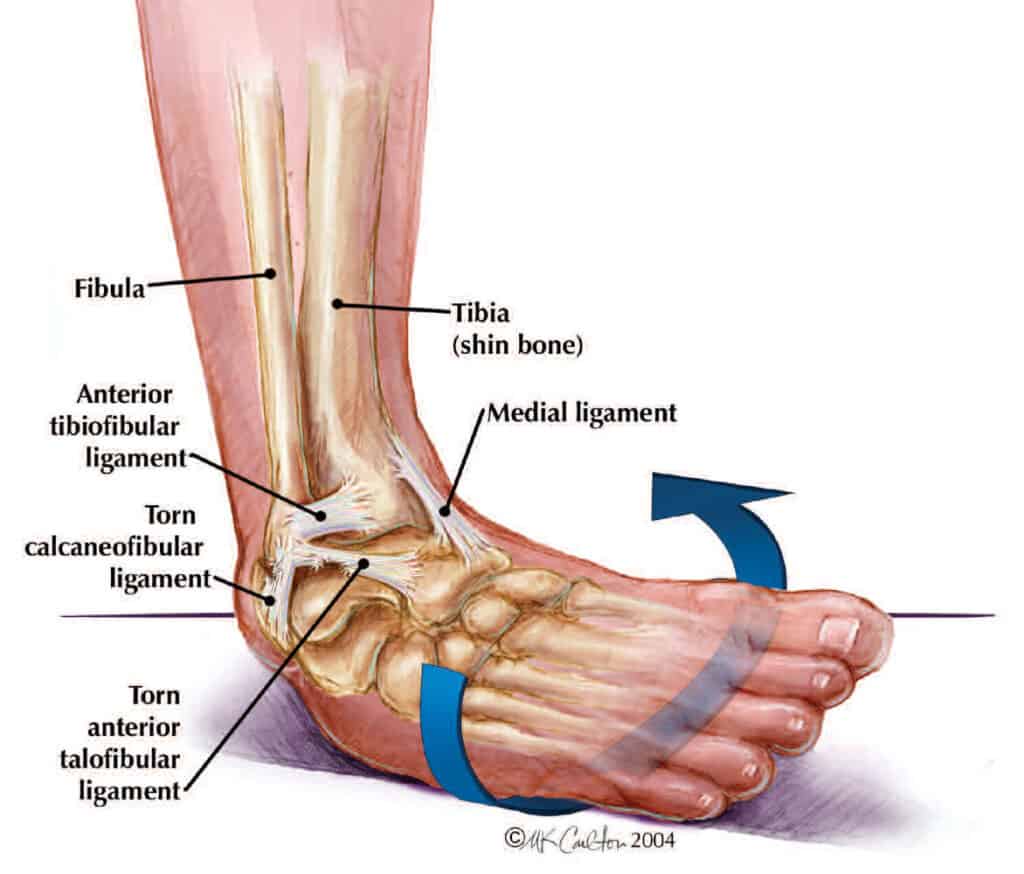How Can a Physiotherapist Help with Ankle Sprains?

An ankle sprain injury is the most common type of foot injury that affects the athletic as well as general population. In the athletic population, ankle sprain can happen when an athlete attempts to jump & twists the ankle while landing
This tends to be common in sports such as AFL, soccer, basketball, netball where there is running &/or change of direction involved. Ankle sprains can account for a significant time away from training or playing the sport.
In the general population, ankle sprain injury is commonly seen when someone twists their ankle on a curb or missing a step, walking on uneven ground or slipping over on wet floors.
Although this type of injury often affects the outside of the ankle (called a lateral or inversion sprain), it can also affect the inside ankle and is called the medial ankle sprain.
If the injury is not complex, it is often treated conservatively & seeing a physiotherapist early is ideal. Sometimes if the injury is more complex, surgery may be required.
Our physiotherapist Pav has put together some information about ankle sprain injury that can give insights about ankle sprain & physiotherapy treatment.
What is an ankle sprain?
What an ankle sprain involves is disruption of the ligaments that support our ankle joint. 85% of the sprains affect the outside of the ankle and involve trauma to the anterior talofibular (ATFL) & calcaneo-fibular (CTFL).
Medial ankle sprain causes disruption of the larger deltoid ligament. Lastly, a high sprain or a syndesmosis injury involves disruption of tibiofibular ligament (AITF), transverse ligaments or interosseous ligaments.
If the force that causes the ankle sprain is high & quick, it can cause a fracture; these fractures account for almost 1-10% of the ankle sprains.
What are the symptoms of ankle sprain?
- Immediate pain
- Swelling & bruising that often develops later
- Sometimes an audible pop or click in the ankle
- Difficulty weight bearing on the injured side
- Reduced range of motion in the ankle joint because of swelling & pain
Generally speaking, the more the swelling & bruising the more severe is the ankle sprain. When there is a fracture associated with a sprained ankle, there can be inability to weight bear on the injured side.
Why do I need to see a physiotherapist for ankle sprain?

Physiotherapists are often the first contact practitioners for ankle sprain injury. Our physiotherapists at Kinesio Physio, can see you early on after a sprain for the assessment & treatment that may be required.
They can provide detailed & appropriate assessment for
- severity of the sprain (grade I, grade II or grade III),
- any suspected bony injuries,
- functional movement assessment,
- any deficits there may be like loss of range of motion, strength, weight bearing capacity.
They can also assist with any further referral that you may need to rule out any sinister issues like fractures.
Depending on the assessment, our physiotherapists at Kinesio Physio are then able to plan an appropriate treatment program.
This assessment & treatment is evidence-based & individualised so we can assist you to return to your favourite activity like playing AFL, going on the hike that you have planned, able to run, able to return to the walking group activities or get back on your feet for the Christmas lunch that you have planned.
What does a physio treatment for ankle sprain involve?

Ideally seeing a physiotherapist in the first 24 – 48 hours after the injury, is a good time frame.
Initial line of treatment is based on the P.E.A.C.E. principle. What P.E.A.C.E means is as below:
P – Protect
The aim is to reduce the load on your ankle joint & the affected ligaments. This may also involve restricting the movement at the ankle joint to reduce any further bleeding & minimize risk of aggravating the injury.
Gone are the days when people were asked to take complete rest. In the Protect phase the aim is to do protected movements; this minimises prolonged rest periods that compromise tissue strength.
Pain can be an effective guide of protection & gradual loading of the affected tissues is advised provided any other sinister concerns are ruled out. Our physios at Kinesio Physio are able to guide you through this.
E – Elevate
Elevating the injured leg & ankle assists in promoting swelling (called interstitial fluid) to flow out of the affected area & promotes faster healing.
A – Avoid anti-inflammatory modalities
Recent research shows that anti-inflammatory medications that you may take after an ankle sprain, may affect the regeneration of the soft tissues & poorly affect the healing process.
Research shows that applying ice, which was a norm until now, may also disrupt the ‘good’ inflammation & new blood vessel formation (re-vascularisation) thus affecting the healing. It may only help to manage the pain.
It is now advised to avoid these anti-inflammatory modalities.
C – Compress
Compression with taping or bandage helps reduce the swelling & internal bleeding that happens when the soft tissues are torn.
Our physiotherapist at Kinesio Physio can provide taping techniques to reduce swelling while maintaining the range of motion in the ankle joint. They may even have pointers for you on how long to leave the tape, how to peel the tape without irritating the skin & show you how to self-bandage the ankle if required.
E – Educate
Our physiotherapists can provide you with education & information about how to actively manage an ankle injury. This can assist to know
- the type & severity of the ankle sprain
- how long will it take for your injury to heal & for you to be back playing, training or doing activity that you enjoy
- what can be the treatment that is individualised for you & depends on your goals
- how to avoid long term effects of ankle sprain such as chronic instability, redoing an ankle sprain when you get back to your functional ability
After the early phase of treatment with P.E.A.C.E., the soft tissues then respond to principles of L.O.V.E.
L – Load
O – Optimisation
V – Vascularisation
E – Exercise
What this phase includes is optimal loading of the soft tissues & gradual exercises that help injured tissues to get stronger. Research has shown that if exercises are progressed gradually in this phase with increasing level of difficulty it helps to
- improve ankle movements
- improve the muscles’ strength
- improve balance & proprioception
Exercises for ankle sprain
Early- Mid stage
- Strengthening exercises for the calf – calf raises (seated or standing)
- Ankle eversion & inversion using thera-bands
- Single leg balance
- Early landing re-training
- Walking
Mid-late stage
- Heavier calf raises work (seated or standing)
- Jumping & hopping (single & double leg)
- Box jumps & landing skills
- Running (straight line, curve)
- Sports/activity specific drills
For more information about how to manage ankle sprains, contact us at 0426 775 381 or BOOK ONLINE to see our physiotherapist at Kinesio Physio.
Written by:
Pallavi Deshmukh
